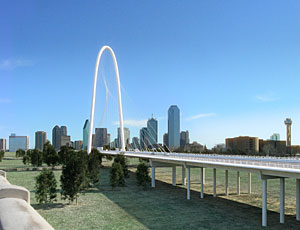
Cost overruns, public opposition, and numerous federal reviews have slowed progress to a crawl. The latest blow was an April report from the Army Corp of Engineers declaring the Trinity River levees unsafe and incapable of withstanding a 100-year flood. The Corps found up to 25 feet of sand where supports for the bridge approaches would go, possibly compromising the entire structure.
The Corps is allowing construction of the bridge deck to proceed, but has halted all work on the approaches pending a review of the levers, which could take two years. All of this has left the future of the bridge—now christened the Margaret Hunt Hill Bridge—up in the air. Supporters have launched a major publicity campaign called “Suspense is Building,” and Dallas mayor Tom Leppert, a big booster, has promised that the bridge will open in 2011 as planned. Others are not so optimistic, citing the glacial pace of federal reviews. The bleakest prediction is for the bridge, and a related toll road, to open around 2016.
The Hunt bridge is one of three Calatrava has designed for Dallas. The second is mostly funded, while the third is still virtual.
David Dillon is a contributing editor at Architectural Record.



Post a comment to this article
Report Abusive Comment